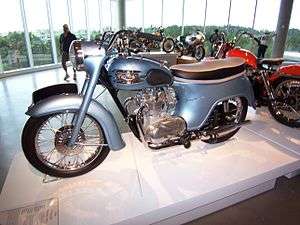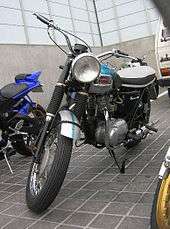Triumph Twenty One
 | |
| Manufacturer | Triumph Engineering Co Ltd |
|---|---|
| Also called | T21, Twenty One, 'Bathtub' |
| Production | 1957–1966 |
| Class | Standard |
| Engine | 349 cc (21.3 cu in), air-cooled, four-stroke, twin |
| Transmission | Four-speed, chain final drive |
The Triumph Twenty One (also known as the 3TA) is a standard motorcycle made by Triumph Engineering Co Ltd in Coventry. The Model Twenty One was the first of the Triumph unit construction twin cylinder motorcycles. Rebranded as the Triumph 3TA in 1959 it continued in production until 1966 when it was survived by the Triumph T90, its sports version.[1]
Development
Launched in 1957 the Model Twenty One was the first of the Triumph unit construction twin cylinder motorcycles from the Meriden factory. With a capacity of 349 cc, the engine was a classic Edward Turner design with a 360 degree crankshaft, twin gear driven camshafts and twin plunger oil pump. The cylinder block was cast iron with an alloy head and separate rocker boxes. The engine was dry sump lubrication and there was a single Amal Monobloc carburettor. Drive was by a conventional four speed gearbox, with a right foot gear lever.[2]
.jpg)
There are two explanations for the 'Twenty One' name spelt out in full on the side panels. The first explanation is that it celebrates the twenty-first anniversary of Triumph Engineering Co Ltd. The second explanation is that the important US export market rated motorcycle engine displacement in cubic inches and 21 cubic inches equates to 350 cc.[3]

In 1959 the Twenty One was rebranded the Triumph 3TA and also produced as a 500 cc version, the Triumph 5TA, which was also referred to as the 'new Speed Twin'. The 'A' designation was a reference to the fact that both motorcycles were fitted with an alternator as standard, as the pre-unit models had been fitted with a Dynamo. The original versions of both the 350 cc and 500 cc models had the fully enclosed rear end which was fashionable in the late 1950s.[3] It was not popular with American customers, where the extra weather protection was less important however, and it got called the 'bathtub'. They also found that the extra sheet metal made access for servicing more complicated.[4] Only the final 3TA model for 1966 dispensed entirely with the rear fairing.

The 3TA and the 5TA both continued in production until 1966 when they were survived by their sportier versions, the T90 and T100 respectively.[1]
See also
References
- 1 2 "Triumph 3TA". Retrieved 2009-04-14.
- ↑ Bacon, Roy (1988). British Motorcycles of the 60's. Osprey Publishing. ISBN 1-85648-166-2.
- 1 2 "A Brief History of Triumph 'C' Range Motorcycles". Retrieved 2009-04-01.
- ↑ Remus, Tim (1997). Triumph Motorcycles: Twins and Triples. MBI Publishing Company. ISBN 978-0-7603-0312-2.